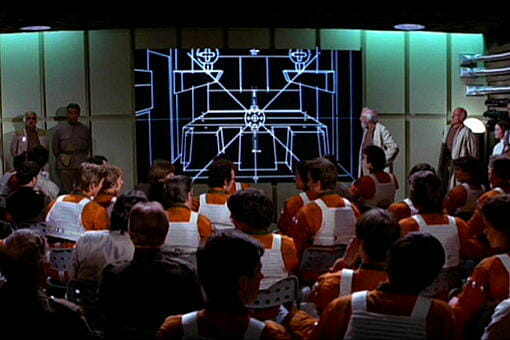Sign up for the
TSL Newsletter
and get $50 off Final Draft 12
By V. Prasad · August 8, 2011

Exposition refers to that information you need the audience to know in order to understand and fully experience your story.
The problem is there isn’t always a natural way to provide this information. Sometimes you have to figure out how to give it to your audience in a way that doesn’t slow the story down or sound clunky coming out of the actors’ mouths.
THE NEED: Deciding on the Exposition Your Audience Needs?
The first thing you need to determine is what information the audience needs to know. To engage the audience, you need to make sure they’re clear on what characters need to accomplish, what’s in their way and what’s at stake if they fail. Any information that clarifies these things for the audience is essential for maintaining suspense.
For example, the audience may need to know what specific steps your character needs to take to achieve his or her goal. At the end of Star Wars, Luke Skywalker’s goal is to destroy the Death Star before it gets in range to fire on the rebel base.
So, George Lucas provides a scene where Luke and the other rebel fighter pilots are briefed on exactly what they need to do in order to complete their mission, providing both them and the audience with the necessary information.
Exposition may also be needed to clarify the obstacles your character has to overcome. In a heist film, this requires explaining all of the security systems a thief has to bypass in order to rob a bank or museum. In an emotional drama, the audience may need to know about events from the protagonist’s past that serve as internal obstacles to what they want or need in the present.
Along those same lines, sometimes exposition is needed to explain why protagonists can’t use the simplest option to getting what they want. You don’t want the audience to say, “But, why didn’t they just do this?” Exposition may be needed to answer that question right off the bat.
Clarifying what is at stake is another purpose of exposition. Disaster and Action/Adventure movies often have to do this. “What will happen if the magic potion falls into the wrong hands?” In those films, it’s important to give the audience a clear picture of what the main characters are trying to prevent. In a sports film, it’s important to know that if the main characters lose their next game, they won’t be eligible for the playoffs. In a courtroom drama, the audience needs to know that if a lawyer doesn’t locate her witness in time, the judge will throw out her case.
If the information doesn’t clarify the goal, the obstacles or the stakes, then you might be able to leave it out.
THE CONFLICT: Using Conflict to Convey Exposition
There are a number of ways to give information to the audience. Bad writers will use awkward dialogue like “Well, Frank, as you know we’ve been friends for four years.” A common mistake in expository dialogue is having one character tell another character what they already know.
Dialogue like that reads extremely awkward because the character is speaking for the audience’s benefit, not for their own. And since the dialogue is not being said to further the character’s interests, the actor playing the part will probably have trouble with the lines because they will lack motivation.
So, in order to make expository dialogue work, characters must have a reason to say the words. They should have something they want and something should be preventing them from getting it. In short, there needs to be a conflict.
Your characters should speak the information you need the audience to hear in order to get something. The information is ammunition they are using to demean, flatter, or threaten someone to get what they want.
The above example could be changed to “Frank, we’ve been friends for four years, you can trust me to pay you back.” It gets across the same information and the information is given to a purpose.
THE WANT: Making the Audience Want Exposition
Another way to make exposition feel natural is to make the audience want to know the information before you give it to them. This is done by arousing their curiosity first.
In a drama, you can allude to an emotional trauma that is haunting a character a few times to arouse the audience’s curiosity. Then, when this backstory comes out it won’t slow down the story because the audience wants to know it. In Casablanca, the audience wants to know what happened between Rick and Ilsa in Paris before they get the answer.
Another way to arouse curiosity is show the audience something that demands an explanation. The movie Back to the Future is very skillful in how it gives exposition to the audience.
To understand what Marty McFly (Michael J. Fox) needs to do so that he can return to his own time period, the audience must know how the time machine that sent him into the past works. The movie accomplishes this by showing the time machine in action first.
This prompts a number of questions from both the audience (and Marty). Only then, does the film give the explanation. The explanation doesn’t feel dry because the audience (and the main character) wants it.
Similarly, in The Matrix, the film depicts a series of events that are completely out of the ordinary. Once the audience (and the main character’s) interest has been peaked, the rather lengthy explanation does not get boring.
Bad exposition can take the audience out of your story. But leaving important information out is not an option if you want to maintain tension. So, whether it’s using conflict or curiosity, find a way to weave in your exposition without the audience noticing.